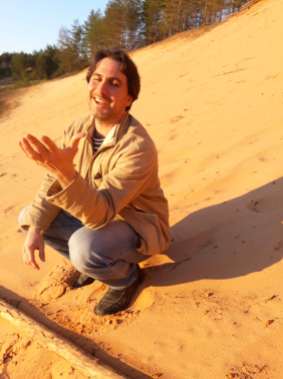IT WAS A FUNNY PHENOMENON. In all my years living in Tartu, I would notice that when summer came, in the weeks after Saint John’s Day, the city would empty out and the streets would be mostly silent and a light breeze would scatter dust down the vacant sidewalks. There was no one around anymore, even though the city’s parks were their most lush and inviting. The peculiar scenes of the academic year — students in corporation uniforms standing on rooftops drinking mugs of beer — disappeared, and Tartu, like most other cities in the south, became a ghost town.
There still were people in the south of Estonia, of course, but they had dispersed to the countryside, and were living at their country houses and farms, scattered and hidden between the mossy forests and rolling hills and lakes. It was harder to see all of the people this way, and one got the sense that there were no people left in the south at all. From Tartu down to Obinitsa and the Russian border, the only evidence of life were the distant lights and smoke from the bonfires.
When you would go out to meet friends in the summer, the geography of the south revealed itself to you in its unknown forms. On the map, everything is spread out for you to see. Everything is held together by roads, intersections, gas stations, signs. On the map, you have a great sense of the distances between places. From Tartu to Võru it’s 73 kilometers, and from Põlva to Võru it’s 27 kilometers. Once you get off the roads though, once you venture into the forests, the distances between minor topographic changes — a hill, a valley — become enormous. One ventures down the steps of, say, Süvahavva to the Võhandu River, discovering forest trails and blue flowers along the way. There are endless discoveries to be made. Every tree here has its own biography.
You can walk for hours like this through the countryside and feel as if you haven’t reached any real destination. It’s one of those ‘the journey is the destination’ kinds of things. No matter where you go in the south, to the little Seto farmsteads in the hinterlands, with their midnight black smoke saunas, you will always find a little path behind the outhouse that leads to another farm, another sauna. There is always something new lurking just beyond those woods, over those hills.
Just when you think you have reached the edge of civilization itself, you spy a light on in a distant cabin window and hear the echo of an accordion. Once you reach the cabin, you realize you have stumbled into a wedding party. An old farmer with a scruffy beard offers you a shot of handsa and you drink it gladly, not really knowing how you got there or where you will go next. This is the true mystery of the south, revealing itself to you one intrigue at a time.
This column appeared in the spring/summer issue of Kõik Koos – Lõunakeskuse Ajakiri. Photos by my daughter, Maria Petrone.




2 thoughts on “mysteries of the south”